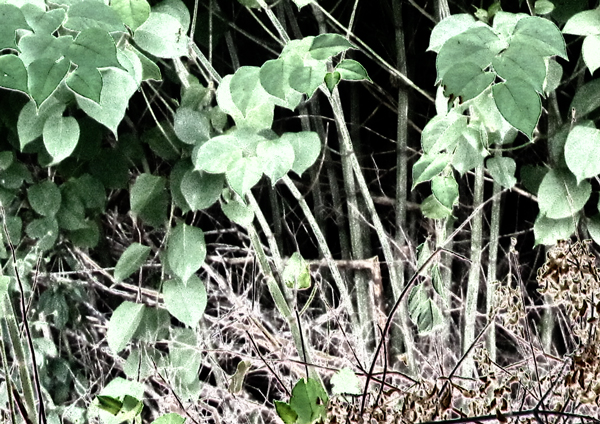After receiving a proposal from Friends of the Mad River and the Mad River Path Association to tackle the problem of invasives on the Austin parcel, the Waitsfield Conservation Commission is going to ask select board approval to re-issue an RFP seeking nonchemical solutions to invasives control.
The Waitsfield Select Board approved a proposal from Redstart to use a combination of manual cutting and herbicide application on one acre of the five-acre Austin parcel in June. That proposal was for a pilot program to get invasives (knotweed, buckthorn and honeysuckle) knocked back so that native species could be planted with a goal of recreating a riparian forest.
After that proposal, the commission held a well-attended public hearing to take feedback from the community on using herbicides (Rodeo, containing glyphosate, and Polaris, containing Imazapyr). The commission regrouped this week to consider the feedback from the forum and next steps.
Between the forum and this week’s meeting, the commission received a proposal from Friends of the Mad River (FMR) and the Mad River Path Association (MRPA) with a plan for a two-year or more plan to tackle invasives. The plan called for the following:
1. Postpone authorizing the use of herbicides on this parcel for at least a period of one year, possibly two years, while we implement mechanical and manual invasive species removal and suppression and begin flood plain forest restoration.
2. Authorize FMR to oversee the invasive species management and flood plain forest restoration scope outlined in the following First Year Work Plan.
3. Authorize MRPA to create and maintain a loop path around the interior of the Austin parcel and accept MRPA commitment to cutting knotweed patches on the interior of the parcel and along the path to keep it at bay as the young trees and other species in the area to be restored as forest flood plain gain a foothold.
4. Authorize FMR and MRPA to manage, train and engage volunteers (and hired workers if necessary) in invasive identification and removal.
5. Approve the sum of $2,000 for this First Year Work Plan to cover management costs, tools and materials, and paid workers, if necessary.
6. Assess the progress and interim success of the First Year Work Plan at the end of one year and, if deemed a success, consider FMR/MRPA to proceed with the second-year work plan based on the experience of the first year’s effort.
The first-year work plan calls for manually pulling buckthorn and honeysuckle, cutting knotweed along the mowed strip and in patches as necessary, monthly or more often as needed, pulling barberry and burning bush and reseeding the flood plain forest restoration area with native species.
The commission took testimony from newcomers to the debate who hadn’t yet weighed in on whether it does or doesn’t make sense to use herbicides as part of a plan to control invasives.
Warren resident Bill Barnes said he was concerned about the distortion and misrepresentation of science and logic. He noted that glyphosate had been on the market since 1974 and has been widely used by farmers in The Valley since that time. He said that if there were health effects from it they would have manifested by now.
Conservation commission chair Phil Huffman asked for thoughts on the process from his fellow commissioners, noting that “It’s clear we may never agree on the science and our interpretation of it as well as how to balance the risks and hazards. That is not our position to take.”
“There are a few items I cling to, actively versus passively changing the trajectory of that parcel. I think doing nothing now is not responsible stewardship for that parcel. This process has been sound and open. We’ve heard a lot of science and a lot of passion. Whatever proposals are put on the table they need to meet a high level of rigor. And ecology is on the march. Whatever we do should be conducted with a moderate amount of haste,” Huffman said.
Commissioners discussed the process and how to solicit and accept new proposals for a nonchemical solution on the Austin parcel, given the course of the public dialogue over the past few weeks. They thanked FMR and MRPA for making the effort to pull together a proposal on short notice.
Huffman said that the commission recommends that a new RFP be issued that is as rigorous as the one that went out last spring that resulted in the proposal from Redstart that involved herbicides for invasives management.
“We have questions about the process and we try to take the process seriously and openly and transparently. We have the option of a nonchemical approach and suggest we put out an RFP for mechanical and manual management. We expect and hope that Friends of the Mad River and the path will respond to it. We feel it is important to start this process again and get select board concurrence next week,” Huffman noted.
“Implicit in what we’ve been saying is that we feel like going forward with herbicides is not the direction we want to go and because there’s support for a nonchemical approach with lots of community support, we’re going to shift direction to follow that and invite proposals around that approach,” he continued.
Ultimately, the commission voted to have two commissioners – Chris Loomis, vice chair, and Ted Joslin – report back to the select board on behalf of the commission and have the working group of commissioners draft a new RFP for a nonchemical approach and then release it for responses.







